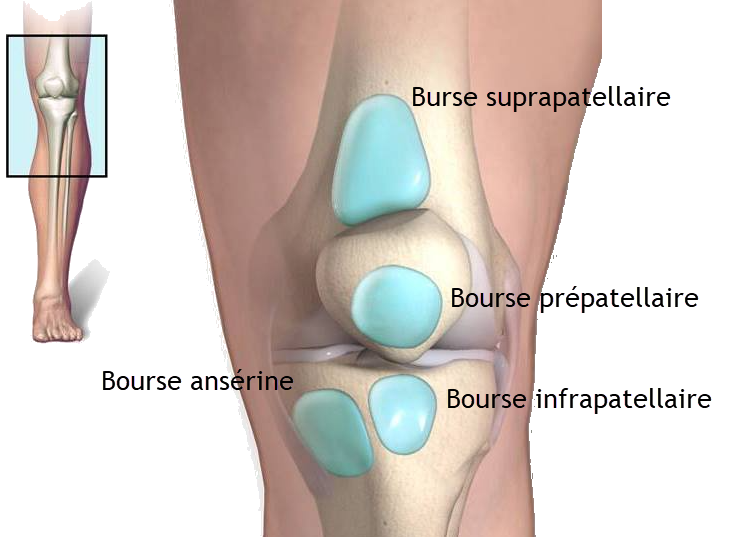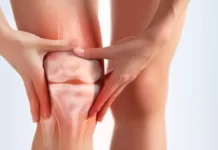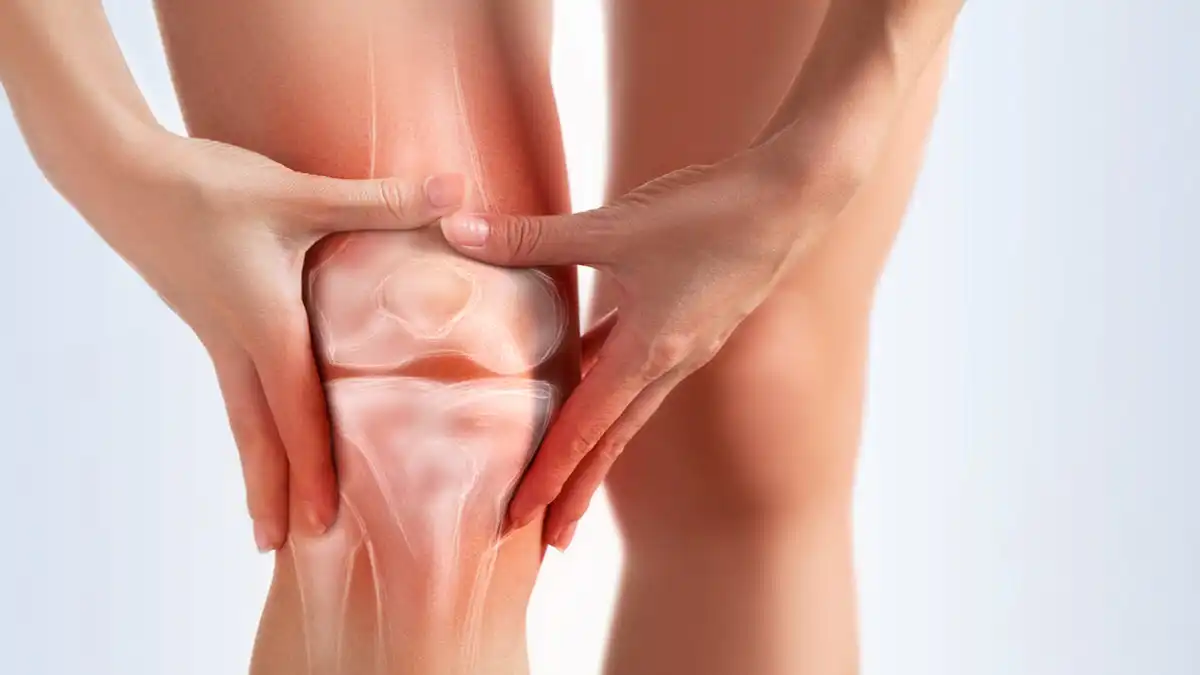Also called prepatellar bursitis, is an inflammation of the suprapatellar bursa, a small fluid-filled cavity located above the kneecap (patella) and below the skin. The suprapatellar bursa helps reduce friction between the kneecap and the quadriceps tendon during knee movements.
Introduction
A bursa is a closed, fluid-filled sac with a smooth surface that helps reduce friction between tissues in the body. When this bursa becomes inflamed, it is called bursitis. In the knee, a complex of four bursae plays a crucial role in maintaining smooth movement and protecting surrounding structures.
The first, the prepatellar bursa, is located above the kneecap, creating a protective layer between the kneecap and the skin. It helps prevent excessive friction during knee movements.
The suprapatellar bursa, meanwhile, is located above the knee, between the femur and the quadriceps tendon. Its strategic position helps facilitate movement and avoid unwanted friction between these structures.
Just below the kneecap, we find the infrapatellar bursa, positioned below the tendon connecting the thigh muscle to the kneecap. This bursa plays a crucial role in protecting the area below the kneecap, minimizing the risk of friction and irritation.
Finally, the anserine bursa is located at the bottom and inside of the knee. This bursa is positioned near the tendons of the muscles that weigh on the inner part of the knee, providing adequate protection and lubrication for these structures.
Each of these bursae has a specific role in maintaining knee mobility while reducing mechanical constraints and minimizing the risk of injury. Knowledge of these structures and their function contributes to a better understanding of the mechanisms underlying bursitis and to the implementation of appropriate prevention and treatment strategies.

Pathophysiology of suprapatellar bursitis
- Initial Stimulation or Irritation:
- Suprapatellar bursitis may be triggered by initial stimulation or irritation of the synovial bursa. This irritation may result from a variety of factors such as repetitive knee movements, prolonged pressure on the suprapatellar region, direct trauma, or infections.
- Inflammatory Response:
- In response to stimulation or irritation, the immune system reacts by triggering an inflammatory response. This inflammatory response involves the release of chemical mediators, such as prostaglandins and cytokines, which lead to increased vascular permeability and infiltration of immune cells into the synovial bursa.
- Accumulation of Synovial Fluid:
- Inflammation causes an increase in synovial fluid production in the bursa. This accumulation of fluid is a protective response that aims to cushion and lubricate the suprapatellar region.
- Synovial Membrane Thickening:
- The synovial membrane lining the bursa becomes thickened due to the inflammatory reaction. This contributes to the formation of an enlarged synovial bursa.
- Formation of a Swollen Bursa:
- The accumulation of synovial fluid and thickening of the synovial membrane leads to the formation of a swollen synovial bursa, which can cause symptoms such as pain, swelling, and limited knee mobility.
- Impact on Surrounding Structures:
- Inflammation of the bursa can affect surrounding structures, including adjacent tendons, muscles, and ligaments. For example, untreated bursitis can lead to irritation of the tendons surrounding the kneecap.
- Changes in Synovial Fluid Composition:
- In cases of prolonged bursitis, the composition of the synovial fluid may change, with increased levels of proteins and inflammatory cells. This may contribute to the chronicity of the condition.
- Formation of Scars and Fibrous Tissue:
- In severe or chronic cases, the inflammatory process can lead to the formation of scars and fibrous tissue inside the synovial bursa. This can lead to a loss of the bursa’s normal elasticity.
- Possibility of Infection (Septic Bursitis):
- In some situations, the synovial bursa can also become infected, leading to a condition called septic bursitis. Infections can be introduced through injuries, insect bites, or other means.
Causes of Suprapatellar Bursitis
- Trauma:
- Direct trauma to the suprapatellar region, such as impact to the patella, can cause inflammation of the synovial bursa.
- Prolonged Pressure:
- Prolonged or repeated pressure on the suprapatellar region, such as that exerted by frequent kneeling, can irritate the synovial bursa and lead to inflammation.
- Repeated Friction:
- Repetitive knee movements, such as excessive flexion and extension, can cause increased friction between the synovial bursa and adjacent structures, contributing to inflammation.
- Infections:
- Although less common, infection of the synovial bursa (septic bursitis) can also lead to suprapatellar bursitis. Infections can be introduced through injuries, insect bites, or other means.
- Inflammatory diseases:
- Certain inflammatory diseases, such as rheumatoid arthritis, may increase the risk of developing suprapatellar bursitis.
- Pre-existing Medical Conditions:
- Underlying medical conditions, such as arthritis, osteoarthritis, or gout, may contribute to the development of bursitis.
- Repeated Reactions to Stress:
- Activities that involve repetitive movements or constant stress on the suprapatellar region, such as running or frequent jumping, may increase the risk of inflammation of the synovial bursa.
- Bad Postures and Overload:
- Poor posture, muscle imbalance or constant overload of the knee can promote the development of suprapatellar bursitis.
Symptoms of Suprapatellar Bursitis
- Pain:
- Pain located above the kneecap is a common symptom. Pain may be felt when extending or flexing the knee.
- Swelling:
- Swelling (puffiness) of the suprapatellar region may occur due to fluid accumulation in the inflamed synovial bursa.
- Redness and Heat:
- The skin above the kneecap may become red and warm due to local inflammation.
- Joint stiffness:
- Stiffness may be felt, limiting knee mobility.
- Touch Sensitivity:
- The affected area may be tender to the touch, and direct pressure on the inflamed synovial bursa may cause pain.
- Crackling:
- In some cases, rubbing or crepitating noises may be felt when moving the knee.
- Aggravation during Activity:
- Pain and discomfort may worsen during certain activities, such as going up or down stairs, running, or prolonged knee bending.
Recommendations for Suprapatellar Bursitis
Recommendations for suprapatellar bursitis aim to relieve symptoms, reduce inflammation, promote healing, and prevent recurrence. Here are some general tips that may be helpful, but it is always best to consult a healthcare professional for advice specific to your situation:
- Rest and Elevation:
- Avoid activities that exacerbate pain, and give your knee adequate rest. Elevate the affected leg when sitting or lying down to reduce swelling.
- Ice Application:
- Apply ice to the suprapatellar region for 15 to 20 minutes every few hours for the first few days of inflammation. Be sure to use a cold compress or ice pack wrapped in a towel to prevent skin burns.
- Non-Steroidal Anti-Inflammatory Drugs (NSAIDs):
- Over-the-counter anti-inflammatory medications, such as ibuprofen, can help reduce pain and inflammation. However, check with your doctor before starting any medication.
- Compression:
- Use a compression bandage to help reduce swelling. Make sure the bandage is not too tight to avoid compromising blood circulation.
- Physiotherapy:
- A physical therapist can recommend specific exercises to strengthen surrounding muscles, improve flexibility, and restore normal knee function.
- Avoid Aggravating Positions:
- Avoid prolonged kneeling positions or activities that put excessive pressure on the suprapatellar region.
- Suitable Shoes:
- Wear appropriate shoes that provide good support and cushioning, especially if you are involved in physical activities.
- Treatment of the Underlying Cause:
- If bursitis is caused by an underlying medical condition, such as arthritis, treating that condition will help resolve the problem.
- Medical consultation:
- Consult a healthcare professional for an accurate diagnosis and recommendations specific to your situation. In some cases, corticosteroid injections or other medical interventions may be necessary.
Conclusion
In conclusion, suprapatellar bursitis is a common and often underestimated condition that can significantly impact a patient’s mobility and quality of life. As osteopaths, our role extends beyond symptom relief. A comprehensive evaluation, including the assessment of biomechanical dysfunctions, muscular chains, and postural habits, enables us to identify and address the factors contributing to the onset and persistence of this condition.
Through targeted manual approaches and interdisciplinary collaboration when necessary, we not only support recovery but also help prevent recurrence by optimizing the overall function of the knee and related structures. This holistic approach is essential in meeting patient expectations and facilitating a sustainable return to their daily activities.
Références
- Magee, D. J. (2021). Orthopedic Physical Assessment. 7th Edition. Elsevier.
- Un ouvrage de référence pour l’évaluation clinique des troubles musculo-squelettiques, y compris les bursites.
- Khan, K. M., & Brukner, P. (2017). Brukner & Khan’s Clinical Sports Medicine: Injuries. 5th Edition. McGraw Hill Education.
- Ressource incontournable pour les blessures liées aux activités physiques, couvrant la bursite et ses traitements.
- Neumann, D. A. (2016). Kinesiology of the Musculoskeletal System: Foundations for Rehabilitation. 3rd Edition. Elsevier.
- Détaille les mécanismes biomécaniques et leur lien avec les troubles tels que la bursite suprapatellaire.
- Cyriax, J. H. (1982). Textbook of Orthopaedic Medicine: Diagnosis of Soft Tissue Lesions. Baillière Tindall.
- Aborde le diagnostic différentiel et les traitements pour les lésions des tissus mous.
- Stedman, J. R., & Timgren, J. (2020). Manual Therapy in the Management of Soft Tissue Disorders. Journal of Bodywork and Movement Therapies, 24(3), 101-112.
- Étude sur les interventions manuelles pour les troubles des tissus mous, y compris la bursite.
- Thys, T., & Bielefeld, T. (2019). “Biomechanics of the Patellofemoral Joint: Relevance in Bursitis.” Journal of Biomechanics, 52, 207-215.
- Un article explorant les dysfonctionnements mécaniques autour du genou et leur rôle dans les conditions inflammatoires.
- Travell, J. G., Simons, D. G., & Simons, L. S. (1999). Myofascial Pain and Dysfunction: The Trigger Point Manual. 2nd Edition. Lippincott Williams & Wilkins.
- Une ressource précieuse sur la douleur myofasciale, utile pour comprendre les facteurs secondaires à la bursite.
- American Osteopathic Association (AOA) (2022). Guidelines for the Management of Joint Disorders.
- Directives pratiques basées sur les meilleures preuves pour gérer les troubles articulaires.
- National Institute for Health and Care Excellence (NICE) (2021). “Management of Soft Tissue Disorders.”
- Recommandations cliniques pour la gestion des troubles inflammatoires et des lésions des tissus mous.
- Adams, M. A., & Dolan, P. (2020). “Postural Habits and Their Influence on Knee Pathologies.” Manual Therapy Research, 18(2), 89-97.
- Une analyse approfondie des habitudes posturales et de leur lien avec les pathologies comme la bursite.






















